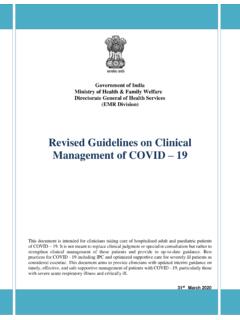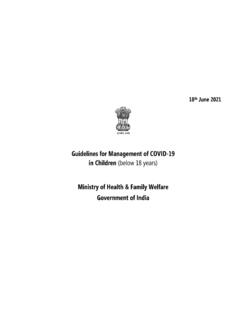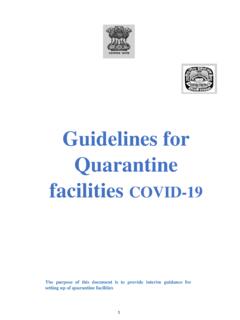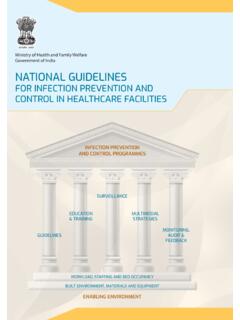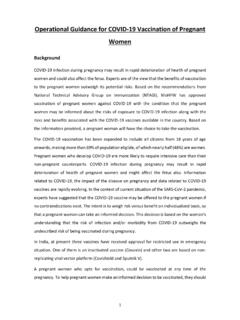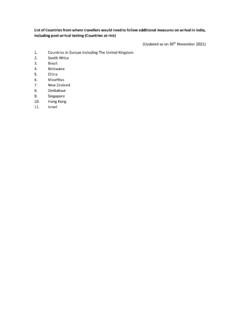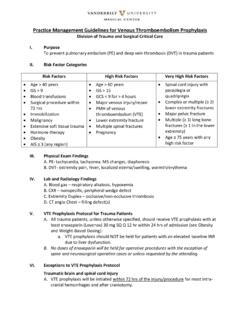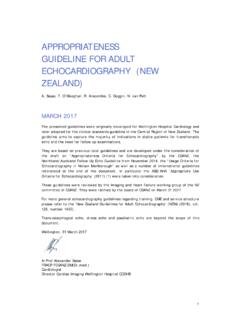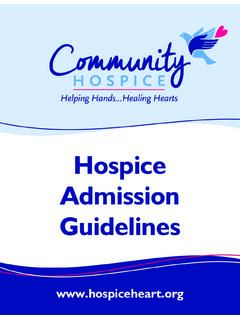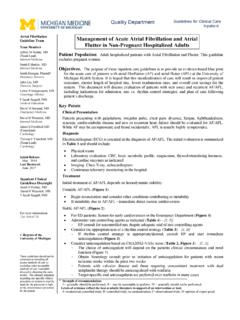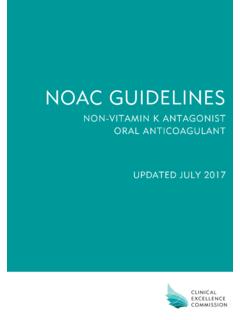Transcription of NATIONAL COMPREHENSIVE GUIDELINES FOR …
1 NATIONAL COMPREHENSIVE GUIDELINES FOR management OF POST-COVID SEQUELAE Ministry of Health and Family Welfare Government of India NATIONAL COMPREHENSIVE GUIDELINES for management of Post-COVID Sequelae [for doctors] Background As we enter the second year of pandemic, patients with ongoing symptoms after recovery from COVID-19 are increasingly recognized as a growing population in need of attention. It has been found that many patients have been experiencing short to long-term sequelae of the dis- ease. Some patients have residual sequelae/symptoms which may or may not be causally linked to COVID-19. In the absence of universally accepted definition, Post-COVID Syndrome by consensus is defined as signs and symptoms that develop during or after an infection consistent with COVID-19 which continue for more than 12 weeks and are not explained by alternative diagnosis.
2 Recent literature also divides post-COVID patients into subacute or ongoing symptomatic COVID (4-12 weeks beyond acute COVID-19) and chronic COVID or Post-COVID syndrome (symptoms persisting beyond 12 weeks of onset of acute COVID-19). Another terminology which is in vogue is the Long COVID that is defined by NATIONAL Institute for Health and Care Excellence as symptoms that continue or develop after acute COVID-19. The timeline of COVID-19 phases and their definitions are shown in figure 1. Scope of the document The purpose of this document is to guide doctors on managing post-COVID complications affecting cardiovascular, gastrointestinal, nephrological, neurological and respiratory systems.
3 Figure 1: Terminology and Definition of Long Covid NATIONAL COMPREHENSIVE GUIDELINES for management of Post-COVID Sequelae [for doctors] Page 2 of 34 Contents Background .. 1 A. GUIDELINES on Post-COVID Cardiovascular Sequel .. 3 Cardiovascular sequelae Post-COVID .. 3 Clinical features: Signs and symptoms .. 4 Investigations .. 4 management .. 5 Conclusion .. 7 B. GUIDELINES on Post-COVID Gastrointestinal Sequelae .. 8 Background .. 8 Risk factors for developing Post COVID GI and Liver manifestations .. 8 Classification of GI symptoms .. 9 management of Post-COVID gastrointestinal manifestations .. 10 Gastrointestinal checklist for long COVID syndrome .. 11 Symptoms .. 11 Investigations .. 11 C. GUIDELINES for Screening and management of Post-COVID-19 Nephrological sequelae.
4 13 Background: Common kidney diseases can be grouped into following major groups .. 13 Common Post-COVID Nephrology related conditions .. 13 What are the symptoms and signs to suspect Post-COVID nephrological related complications? When do we suspect Post-COVID nephrological complications/ sequelae? .. 15 What are the minimum facilities required for treating these conditions? .. 16 D. GUIDELINES for management of Post-COVID Neurological Sequelae .. 18 Background: .. 18 Common Post-acute COVID 19 Neurological Symptoms: .. 18 Diagnosis and management of Post-COVID sequelae: .. 22 Investigations for Post-COVID patients with neurological sequelae: .. 22 Care and follow up of Post-COVID patients: .. 23 Annexure 1 .. 27 Annexure 2: IV Antiepileptics for management of SE.
5 28 E. GUIDELINES for the management of Long-Term Respiratory Effects of COVID-19 .. 29 When do we suspect that the patient is having long term respiratory effects of COVID-19? .. 29 What should be the initial evaluation of a patient with suspected long-term respiratory effects of COVID-19? .. 30 Initial treatment offered to patients with Post-COVID respiratory sequelae? .. 32 management of specific Post-Covid pulmonary conditions .. 33 A. GUIDELINES on Post-COVID Cardiovascular Sequel Cardiovascular sequelae Post-COVID Cardiovascular sequelae not only occur in symptomatic COVID-19 patients but have also been reported in asymptomatic patients. Up to 20% 30% of patients hospitalized with severe COVID-19 have evidence of myocardial involvement manifested by elevated troponin levels, venous thrombo- embolism , heart failure and arrhythmias.
6 Elevated troponins in acute symptomatic patients have been associated with poor outcomes and higher in hospital mortality rates. There are multiple mechanisms proposed to explain cardiovascular complications of COVID-19. Direct cardiomyocyte damage or damage secondary to hypoxia, microvascular dysfunction, thrombosis, and cytokine storm have been implicated. Given the high prevalence of cardiac injury, it is reasonable to expect a spectrum of heart disease with some residual post myocarditis abnormalities in severe cases. Myocardial involvement is presumed to be the initiator of inflammatory process and subsequent fibrosis (detectable on cardiac magnetic resonance imaging) and long-term sequelae too.
7 The long-term sequelae include increased cardio- metabolic demands, myocardial fibrosis or myocardial scar, persistent left ventricular dysfunction, heart failure, arrhythmias, inappropriate sinus tachycardia and autonomic dysfunctions. Many of the lingering signs and symptoms in patients after recovery from COVID-19 especially fatigue, dyspnea and chest pain are non-specific. This may occur denovo in an asymptomatic COVID-19 patients or in symptomatic COVID-19 patients with no clinically apparent cardiac involvement during the acute phase. Patients who develop viral myocarditis, myocardial infarction, pulmonary embolism , stress induced myocardial injury and arrhythmias during the acute phase are at higher risk of developing long-term cardiovascular complications and poor outcomes.
8 These subsets of patients typically have comorbidities such as diabetes, hypertension, obesity, dyslipidemia and chronic kidney disease which would complicate their recovery after the acute phase. Chest pain has been reported in ~20% of COVID-19 survivors at sixty-day follow-up. Palpitations have reported in ~10% of COVID-19 survivors at sixty-day follow-up. Ongoing chest pain and palpitations have been reported in 5% and 9% respectively at six-month follow-up post-acute COVID-19. Stress cardiomyopathy is 4-5 times more common during the COVID-19 pandemic when compared to pre-pandemic periods ( versus ). Myocardial inflammation detected on cardiac MRI was found in as many as 60% of affected people more than 2 months after a diagnosis in one study.
9 However, such high prevalence of myocardial involvement has not been replicated in other studies and the clinical implications, if any, of these findings is not known. Retrospective studies have found the rate of venous thromboembolism in the post-acute COVID-19 setting to be <5%. However, the vast majority of patients who have asymptomatic/mild NATIONAL COMPREHENSIVE GUIDELINES for management of Post-COVID Sequelae [for doctors] Page 4 of 34 COVID-19 do not have any serious sequalae. Case control studies have shown no excess cardiac involvement in survivors of COVID-19 infection as compared to controls. Clinical features: Signs and symptoms Profound fatigue is the most common symptom in most people with Long COVID.
10 Other symptoms such as chest pain, dyspnea and palpitations are well described symptoms in patients with cardiac sequelae. Chest pain consistent with typical angina should be differentiated from atypical or non-anginal chest pain on the basis of location, aggravating and relieving factors. Likewise, respiratory causes of dyspnea need to be differentiated from cardiac causes. Heightened suspicion of dyspnea of cardiac origin especially in the setting of acute coronary syndrome, pulmonary embolism , myocarditis and tachyarrhythmias is the key for early diagnosis of worsening cardiac status and initiating appropriate treatment. Palpitations in Post-COVID syndrome could be due to inappropriate sinus tachycardia, postural orthostatic tachycardia syndrome consequent to hyperadrenergic state or premature ventricular contractions or ventricular arrhythmias consequent to myocardial fibrosis and scarring.

